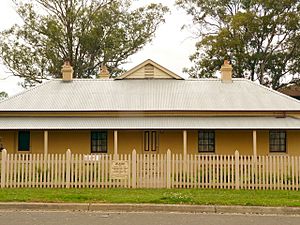The Manse, Mount Druitt facts for kids
Quick facts for kids The Manse |
|
|---|---|

The Manse, 2010
|
|
| Location | 23 The Avenue, Mount Druitt, Sydney, New South Wales, Australia |
| Built | c. 1880s |
| Owner | Blacktown City Council |
| Official name: The Manse; Methodist Manse | |
| Type | State heritage (built) |
| Designated | 2 April 1999 |
| Reference no. | 206 |
| Type | Presbytery/Rectory/ Vicarage/Manse |
| Category | Religion |
| Builders | probably by local notable, John Harris |
| Lua error in Module:Location_map at line 420: attempt to index field 'wikibase' (a nil value). | |
The Manse is a special old house in Mount Druitt, Sydney, New South Wales, Australia. It used to be a home but is now a community museum. People think a local builder named John Harris built it around the 1880s. It's also known as the Methodist Manse. The Blacktown City Council owns this important building. It was added to the New South Wales State Heritage Register on April 2, 1999, which means it's protected because of its history.
Contents
History of The Manse
Early Days of Mount Druitt
Mount Druitt is an area with a rich history in New South Wales. It was one of the first places settled by Europeans. This area, along with Prospect and Colyton, was about 45 kilometers west of the first Sydney Cove settlement.
In 1821, Governor Macquarie gave 1000 acres of land to Major George Druitt. Major Druitt was an important officer and engineer. He helped build many structures designed by architect Francis Greenway. The land given to Major Druitt became known as the "Mount Druitt" estate.
The Manse's Land and Building
The land where The Manse stands today was part of Major Druitt's original grant. Over the years, this land changed owners many times. In 1881, a real estate agent named George Kennedy King bought a large part of the old estate. He then divided the land into smaller sections.
The Manse was built on one of these sections. We don't know the exact date it was built, but it was likely in the late 1880s. It is a single-story brick house with a classic Victorian Georgian style. It has a sloped roof and a verandah on two sides. Many believe local builder John Harris built it.
A Home for Ministers
The Kennedy family owned The Manse until about 1895. They were very religious Presbyterians. When a new church was being built, there was no home for the minister. So, the Kennedy family generously gave The Manse to the Presbyterian Church. It then became a "manse," which is a house for a church minister.
From 1896 onwards, The Manse was home to many Presbyterian ministers. Reverend George Milne lived there from about 1913 until 1930.
The Manse Today
After some changes within the Church, the Blacktown City Council bought the house in 2001. They rented it out as a home for a while. During this time, some original features like a fireplace and an organ went missing.
From 2007 to 2008, the Council worked to fix up and restore the property. They wanted to prepare it for community use. Today, The Manse is home to the Mount Druitt Historical Society. It is the oldest building still standing in Mount Druitt.
What The Manse Looks Like
The Manse Building
The Manse is a single-story brick house built in the Victorian Georgian style. It has a rectangular shape with a hipped roof (a roof that slopes on all four sides). There is also a verandah (a covered porch) on two sides. Some parts, like a small roof vent and the verandah floor, have been updated more recently.
The Manse Reserve Area
The land around The Manse is called The Manse Reserve. It has different sections. The most noticeable part is at the corner of The Avenue and Mount Druitt Road. This area has many old Eucalyptus trees and long grasses. There is also a car park near the corner.
An open grassy area and a gravel car park connect this part to The Manse itself. The historic building is towards the eastern side of the property. It is surrounded by old trees and open grass. The building is very important to the area, and it has been undergoing repairs.
Next to The Manse are other facilities, like the "Meals on Wheels" building. The area to the south and east of The Manse has mown grass and more scattered Eucalyptus trees. There are also some old farm fences, which remind us of the area's past as farmland.
Plants in the Reserve
The native trees in the reserve are similar to those found in nearby areas. They include trees like grey box and narrow-leafed ironbark. While there aren't many native shrubs left, these trees show what the original woodland might have looked like.
Some common native grasses that would have grown here include kangaroo grass. There are also some non-native plants around The Manse, like privet and oleander. These plants are not part of the original landscape.
The reserve has not been developed much for public use, apart from the car parks and some fences. The car parks are not in the best condition.
Fences Around The Manse
There are different types of fences around The Manse Reserve. These include boundary fences, post and rail fences, and security fences around The Manse building. There are also some old post and wire farm fences at the back of The Manse. These fences remind us that the area used to be more rural. Many of these fences need repairs.
Heritage Listing
The Manse was officially listed on the New South Wales State Heritage Register on April 2, 1999. This means it is recognized as an important historical site in New South Wales.


